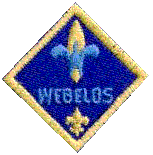
Webelos Scouts
According to the "History of Cub Scouting", the original Cubbing (as it was known before 1945) handbooks listed Akela as an Indian boy, son of the Chief of the Webelos Tribe. The chief of the tribe was know as Arrow of Light; a name adapted from the Arrow Park World jamboree in London in 1929. The term Akela was taken from the leader of the wolf pack in The Jungle Book.
Webelos
at this time was explained as " a word of inner
meaning, signifying progress from Wolf through Bear and
Lion ranks: W_B_L_S....We'll be loyal Scouts." Also,
the first letters of Wolf, Bear, Lion, Scout. The latter
definition was dropped when the Lion badge was eliminated.
Later, Akela
became the chief of the Webelos Tribe.
The
Webelos rank was created in 1941. The Webelos badge at
this time was the familiar Arrow of Light Badge. The
Webelos den idea encouraging the transition into Boy
Scouts was put into effect in the spring of 1954. A
Webelos den badge of a blue W in a gold diamond was
introduced. They were still called Cub Scouts until the
term Webelos Scout was introduced in 1967 when 15
activity badges were introduced and the Lion badge was
dropped. The Arrow of Light then became Cub Scouting's
highest honor separate from the Webelos rank.
Webelos Colors
The Webelos colors were introduced with the "new" Webelos program in 1967. This program offered metal pins referred to as Activity Badges for meeting requirements. But where to put the badges on the uniform that would not detract from other awards and clutter the uniform?
The answer came from Baden-Powell's very first Scout camp out at Brownsea Island in England. On August 1, 1907, each boy was provided with a shoulder knot, a long streamer of colored tape. The color of the tape designated the patrol that the boy belonged to.
It is comprised of woven red, gold and a green streamer on a metal bar. The metal bar has a blue backing with gold border and lettering spelling out Webelos. It is thought that the colors represented the various levels of Scouting; gold for Cub Scouts, green for Boy Scouts, and Red for Explorers. The "assigned" colors changed in 1980 with the Boy Scouts and Explorer colors reversing as new uniforms were introduced.
Originally, there were only 15 activity pins and no more than five pins were to placed on each streamer. The cloth den numeral was removed and a metal numeral with a rounded top was centered on the yellow (gold) streamer. The numerals were not to be used until the Pack had more than one Webelos den.
It is now an optional uniform item. It probably lost popularity due to it being in a place where it could easily be knocked off the uniform during horseplay. The colors became known as having "weak" attaching pins. If the colors and badges were lost, the cost of replacement was very expensive. Also, the wearing of pins on cowboy hats and ball caps has become popular. The placement of pins on the Webelos cap reflects this trend.
It is worn on the right sleeve and in 1967 was placed below the shoulder seam. As the flag was added to the uniform ,it was worn immediately below and touching the U.S. Flag. The top was squared off to fit better under the flag. Today, if a den number is worn, it is placed under and touching the den number.
The national office was going to eliminate the Webelos Colors in the late 80's, however, an outcry from the field brought them back. Although, in today's Webelos books it is difficult to find pictures or references to the colors.